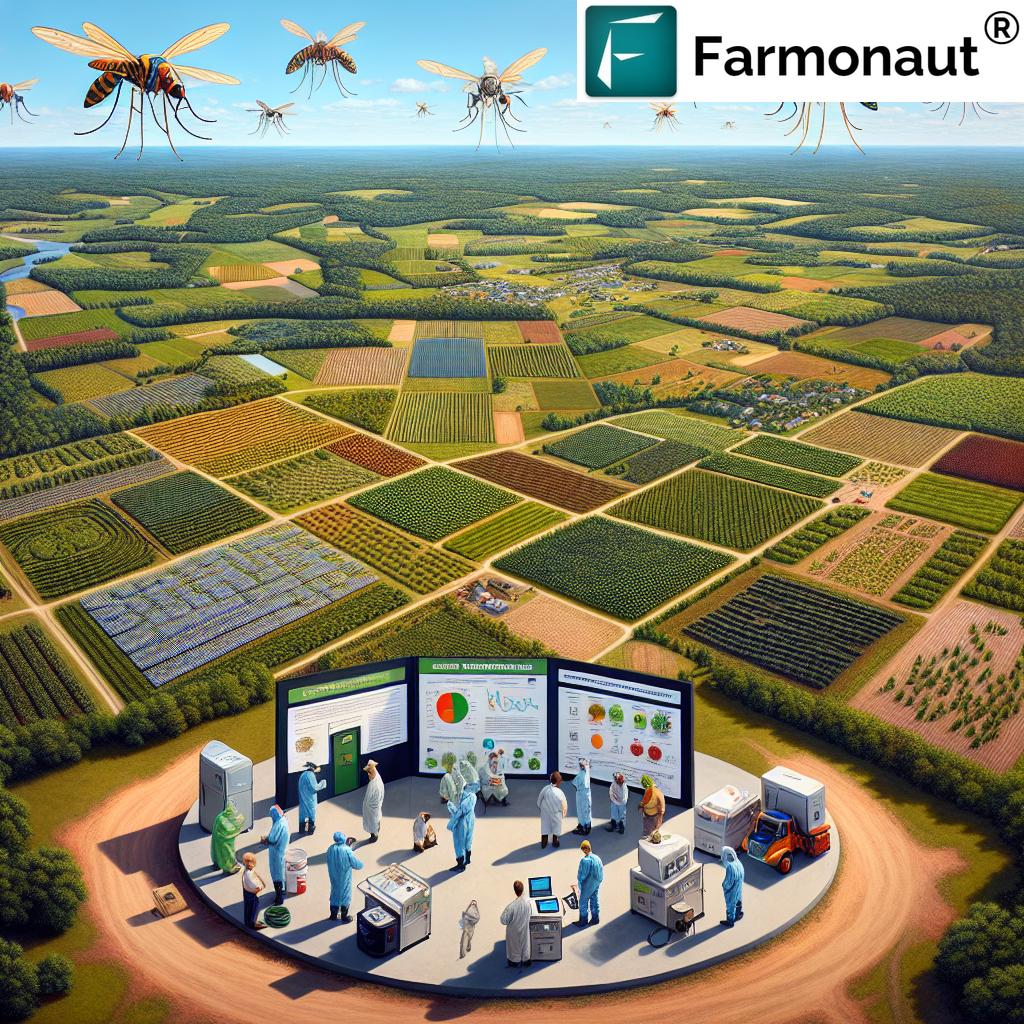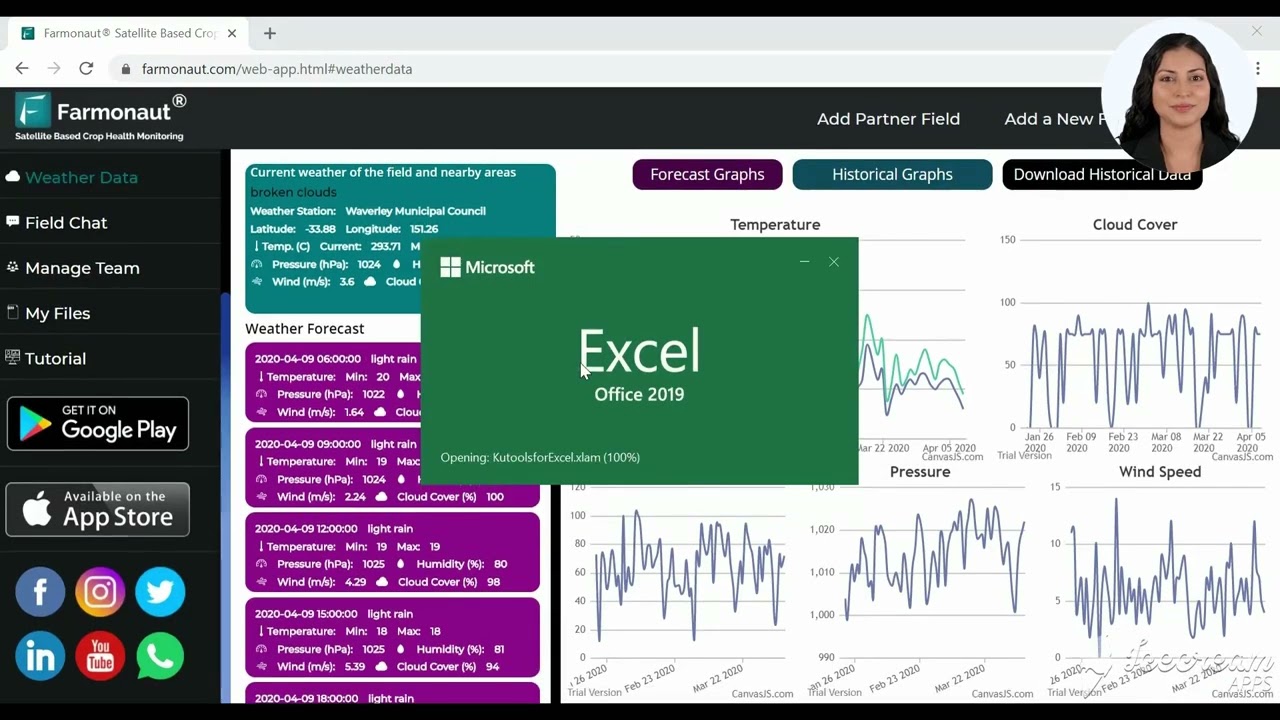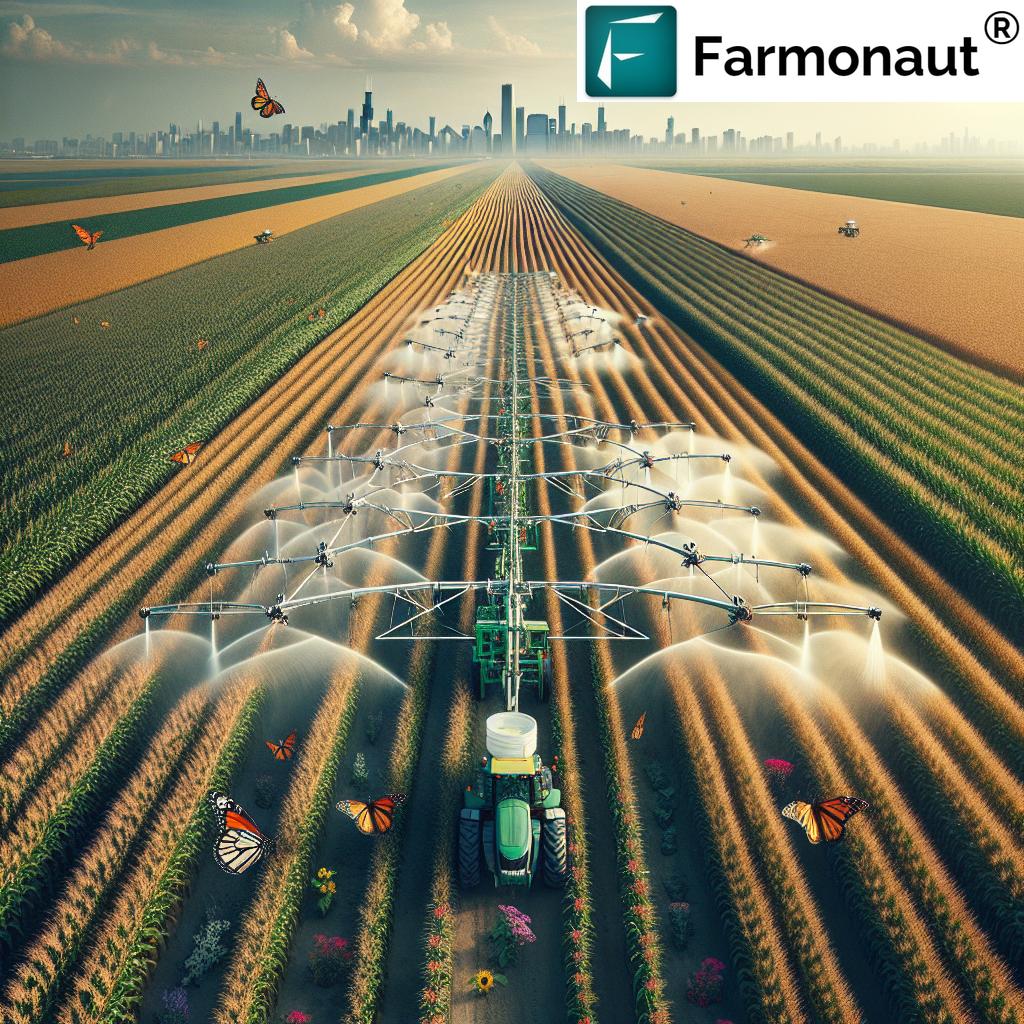Protecting Massachusetts Farms: Smart Mosquito Surveillance and EEE Prevention Strategies with Farmonaut

“EEE virus in Massachusetts affects over 60% of agricultural communities, impacting both crop and livestock production.”
As we delve into the critical issue of Eastern equine encephalitis (EEE) virus detection in Massachusetts, we recognize the growing concerns within our agricultural communities and among our farmers. The impact of mosquito-borne diseases on agriculture is a pressing matter that requires immediate attention and innovative solutions. In this comprehensive exploration, we’ll uncover smart farming solutions for pest control, with a particular focus on how integrated pest management and precision agriculture techniques can help mitigate risks associated with EEE and other insect-borne threats.
At Farmonaut, we’re committed to providing cutting-edge agritech innovations for effective mosquito surveillance and crop protection. Our mission is to empower farmers with the tools and knowledge they need to safeguard their livelihoods and the health of their communities. Let’s embark on this journey to understand the complexities of EEE prevention and discover how modern farming practices and technology can contribute to reducing the spread of mosquito-borne diseases in rural areas.
Understanding the EEE Threat in Massachusetts
Eastern equine encephalitis is a rare but severe mosquito-borne illness that poses a significant threat to both human and animal health. In Massachusetts, the virus has been detected in various counties, raising alarm bells for farmers and residents alike. The state Department of Public Health conducts regular surveillance from April through October each year to monitor mosquito activity and virus presence.
- EEE virus typically cycles between birds and mosquitoes in swampy areas
- Humans and horses can become infected through the bite of an infected mosquito
- The virus can cause severe neurological damage and has a high mortality rate
For our agricultural community, the implications of EEE extend beyond human health concerns. Livestock, particularly horses, are highly susceptible to the virus, which can lead to significant economic losses for farms. Moreover, the presence of EEE-carrying mosquitoes can impact farm workers’ safety and productivity, necessitating robust prevention strategies.
The Impact of EEE on Massachusetts Agriculture
The agricultural sector in Massachusetts faces unique challenges when it comes to EEE prevention and control. Our farmers must balance the need for effective pest management with sustainable farming practices and environmental stewardship. Here’s how EEE affects various aspects of agriculture in the state:
- Livestock Health: Horses are particularly vulnerable to EEE, with a mortality rate of up to 90% in infected animals
- Crop Production: While crops aren’t directly affected by the virus, the presence of EEE can disrupt farming activities and reduce productivity
- Worker Safety: Farm laborers are at increased risk of exposure to infected mosquitoes, especially during dawn and dusk hours
- Economic Impact: EEE outbreaks can lead to quarantines, reduced tourism, and decreased demand for local agricultural products
To address these challenges, we at Farmonaut advocate for a comprehensive approach that combines traditional farming wisdom with advanced technology. Our satellite-based farm management solutions offer real-time insights that can be crucial in implementing effective mosquito control measures.
Smart Farming Solutions for Mosquito Control
In the fight against EEE and other mosquito-borne diseases, smart farming techniques play a pivotal role. By leveraging technology and data-driven approaches, farmers can create environments that are less hospitable to mosquitoes while maintaining productive agricultural operations.
Integrated Pest Management (IPM) in Agriculture
Integrated Pest Management is a holistic approach that combines various strategies to control pests effectively while minimizing environmental impact. For mosquito control in agricultural settings, IPM may include:
- Biological control using natural predators
- Habitat modification to reduce mosquito breeding sites
- Targeted use of EPA-approved pesticides
- Regular monitoring and surveillance of mosquito populations
Farmonaut’s satellite imagery and AI-powered analytics can assist in identifying potential mosquito breeding sites across vast agricultural areas, allowing for more targeted and efficient IPM implementation.
Precision Agriculture for Disease Prevention
Precision agriculture techniques offer powerful tools for managing farm environments to reduce mosquito populations. Some key strategies include:
- Optimized irrigation management to prevent standing water
- Precision application of mosquito control products
- Use of drone technology for targeted spraying in hard-to-reach areas
- Data-driven decision-making for timing of control measures
Our Farmonaut platform integrates seamlessly with precision agriculture systems, providing farmers with actionable insights to implement these strategies effectively.
Agricultural Mosquito Surveillance: A Key to EEE Prevention
Effective mosquito surveillance is crucial for early detection and prevention of EEE outbreaks. In Massachusetts, the state laboratory conducts regular testing of mosquito samples collected from various sites. For farmers, implementing a robust surveillance program on their properties can provide valuable data to inform control measures.
Components of an Effective Agricultural Mosquito Surveillance Program:
- Regular monitoring of mosquito populations using traps
- Identification of mosquito species present on the farm
- Testing of mosquito samples for EEE and other viruses
- Mapping of potential breeding sites and high-risk areas
- Collaboration with local health departments for data sharing
Farmonaut’s satellite-based crop monitoring system can be adapted to support mosquito surveillance efforts by identifying areas of standing water or dense vegetation that may harbor mosquito populations. This information, combined with on-the-ground surveillance data, can create a comprehensive picture of mosquito activity on farms.
“Integrated pest management techniques can reduce mosquito populations by up to 80% on farms, minimizing EEE risks.”
Crop Protection from Insect Vectors
While EEE primarily affects humans and horses, the mosquitoes that carry the virus can also impact crop health indirectly. Protecting crops from insect vectors is an essential part of a comprehensive EEE prevention strategy. Here are some effective methods:
- Barrier Treatments: Application of long-lasting insecticides around crop perimeters
- Crop Selection: Choosing varieties that are less attractive to mosquitoes
- Timing of Planting and Harvesting: Adjusting schedules to avoid peak mosquito activity periods
- Cover Crops: Using cover crops that repel mosquitoes or attract beneficial predators
Farmonaut’s advanced crop monitoring tools can help farmers track the health of their crops and detect any patterns that might indicate increased insect activity. By integrating this data with weather forecasts and mosquito surveillance information, farmers can make informed decisions about when and how to implement crop protection measures.

Risk Management Strategies for Farmers
Managing the risk of EEE on farms requires a multi-faceted approach that goes beyond mosquito control. Farmers in Massachusetts should consider the following risk management strategies:
- Employee Education: Training farm workers on EEE risks and prevention measures
- Personal Protective Equipment (PPE): Providing appropriate clothing and repellents for outdoor work
- Scheduling: Adjusting work hours to avoid peak mosquito activity times
- Infrastructure Improvements: Installing screens on buildings and maintaining proper drainage
- Insurance Coverage: Reviewing and updating farm insurance policies to cover potential EEE-related losses
Farmonaut’s API can be integrated with farm management systems to provide real-time alerts on environmental conditions that may increase EEE risk, allowing farmers to take proactive measures to protect their workforce and livestock.
Agritech Solutions for EEE Prevention
The role of agricultural technology in combating EEE cannot be overstated. Innovative agritech solutions are providing farmers with powerful tools to monitor, predict, and respond to mosquito-borne disease threats. At Farmonaut, we’re at the forefront of this technological revolution, offering a range of solutions tailored to the needs of modern farmers.
Satellite-Based Monitoring for Mosquito Habitat Detection
Our satellite imagery analysis can identify areas of standing water, dense vegetation, and other potential mosquito breeding sites across large agricultural areas. This bird’s-eye view allows for more efficient resource allocation in mosquito control efforts.
AI-Powered Predictive Models
By analyzing historical data on weather patterns, mosquito populations, and EEE outbreaks, our AI algorithms can predict high-risk periods for mosquito activity. This enables farmers to implement preventive measures proactively.
Mobile Apps for Real-Time Monitoring
Our mobile applications allow farmers to report mosquito sightings, track control measures, and receive alerts about EEE risk levels in their area. This crowd-sourced data enhances the overall surveillance efforts.
To access these cutting-edge tools, farmers can download our apps:
Collaboration and Community Efforts
Effective EEE prevention requires a collaborative approach involving farmers, local communities, and government agencies. Here are some ways to foster cooperation:
- Community Education Programs: Organizing workshops and informational sessions on EEE prevention
- Farmer Networks: Establishing peer-to-peer support groups for sharing best practices
- Public-Private Partnerships: Collaborating with local health departments and universities for research and surveillance
- Regional Coordination: Participating in county-wide or state-level mosquito control initiatives
Farmonaut supports these collaborative efforts by providing a platform for data sharing and analysis. Our API Developer Docs enable integration with other systems, facilitating a more coordinated response to EEE threats.
Comparative Analysis of EEE Prevention Strategies
To help farmers make informed decisions about EEE prevention, we’ve compiled a comparative analysis of various strategies:
| Prevention Strategy | Effectiveness Rating (1-5) | Implementation Complexity | Cost Estimate | Benefits for Crop Protection | Benefits for Livestock Protection | Integration with Farmonaut Technology |
|---|---|---|---|---|---|---|
| Integrated Pest Management (IPM) | 5 | High | $$$ | High | High | Full integration with satellite monitoring and AI advisory |
| Mosquito Habitat Reduction | 4 | Medium | $$ | Medium | High | Satellite imagery for identifying potential breeding sites |
| Precision Agriculture Techniques | 4 | High | $$$ | High | Medium | Full integration with Farmonaut’s precision agriculture tools |
| Agricultural Mosquito Surveillance | 5 | Medium | $$ | Medium | High | Integration with Farmonaut’s monitoring and alert systems |
| Livestock Vaccination | 3 | Low | $$ | Low | High | Tracking through Farmonaut’s livestock management features |
| Employee Education and Training | 4 | Low | $ | Medium | Medium | Access to educational resources through Farmonaut’s platform |
This table provides a comprehensive overview of the various EEE prevention strategies available to Massachusetts farmers. By considering the effectiveness, complexity, cost, and benefits of each approach, farmers can develop a tailored plan that best suits their specific needs and resources.
Staying Informed: Current EEE Activity Levels and Resources
Keeping up-to-date with the latest information on EEE activity is crucial for effective prevention. Here are some key resources for Massachusetts farmers:
- Massachusetts Department of Public Health: Regular updates on EEE risk levels by county
- Local Mosquito Control Projects: Information on mosquito control activities in specific areas
- USDA Farm Service Agency: Updates on agricultural programs and support related to pest management
- University of Massachusetts Extension: Research-based information on integrated pest management for farms
Farmonaut’s platform aggregates data from these sources and integrates it with our satellite imagery and AI analysis to provide farmers with a comprehensive view of EEE risk in their area. Our web app serves as a one-stop resource for all EEE-related information and prevention strategies.
Future Outlook: Innovations in EEE Prevention
As we look to the future, several promising innovations are on the horizon that could revolutionize EEE prevention in agriculture:
- Gene Drive Technology: Potential for modifying mosquito populations to reduce EEE transmission
- Advanced Repellents: Development of long-lasting, environmentally friendly mosquito repellents
- Drone-Based Larvicide Application: Precision treatment of breeding sites in hard-to-reach areas
- IoT Sensors: Real-time monitoring of environmental conditions conducive to mosquito breeding
At Farmonaut, we’re committed to staying at the forefront of these technological advancements. Our research and development team is constantly exploring new ways to integrate cutting-edge innovations into our platform, ensuring that Massachusetts farmers have access to the most effective tools for EEE prevention.
Conclusion: A Proactive Approach to EEE Prevention
As we’ve explored throughout this article, protecting Massachusetts farms from the threat of Eastern equine encephalitis requires a multifaceted, proactive approach. By combining traditional farming wisdom with modern technology and data-driven insights, farmers can significantly reduce the risk of EEE outbreaks while maintaining productive and sustainable agricultural operations.
The key takeaways for effective EEE prevention include:
- Implementing comprehensive integrated pest management strategies
- Leveraging precision agriculture techniques for mosquito control
- Conducting regular agricultural mosquito surveillance
- Utilizing advanced agritech solutions for monitoring and prediction
- Fostering collaboration between farmers, communities, and government agencies
- Staying informed about current EEE activity levels and prevention resources
At Farmonaut, we’re dedicated to supporting Massachusetts farmers in their efforts to combat EEE and other agricultural challenges. Our satellite-based farm management solutions, AI-powered analytics, and mobile applications provide the tools needed to implement effective prevention strategies and make informed decisions.
By embracing smart farming practices and leveraging the power of technology, we can work together to create a more resilient and healthy agricultural landscape in Massachusetts. Let’s continue to innovate, collaborate, and adapt in the face of challenges like EEE, ensuring a prosperous future for our farms and communities.
FAQ Section
Q: What is Eastern equine encephalitis (EEE)?
A: EEE is a rare but serious mosquito-borne virus that can cause inflammation of the brain. It primarily affects horses and humans and can be fatal in many cases.
Q: How does EEE impact agriculture in Massachusetts?
A: EEE affects agriculture by posing health risks to livestock (especially horses), farm workers, and potentially disrupting farm operations during outbreaks.
Q: What are some effective mosquito control methods for farms?
A: Effective methods include integrated pest management, habitat modification, targeted use of EPA-approved pesticides, and biological control using natural predators.
Q: How can Farmonaut’s technology help in EEE prevention?
A: Farmonaut offers satellite-based monitoring to identify potential mosquito breeding sites, AI-powered predictive models for risk assessment, and real-time alerts through mobile apps.
Q: Are there any government resources available for farmers dealing with EEE?
A: Yes, the Massachusetts Department of Public Health, local Mosquito Control Projects, and the USDA Farm Service Agency provide information and support for EEE prevention.
Farmonaut Subscriptions
To access our full range of EEE prevention tools and farm management solutions, consider subscribing to Farmonaut’s services:
By investing in Farmonaut’s technology, you’re not just protecting your farm from EEE; you’re embracing a smarter, more sustainable approach to agriculture that will benefit your operations for years to come.




















